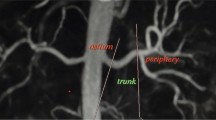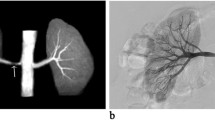Abstract
This study aims to evaluate the feasibility of computational fluid dynamics (CFD) technology in analysis of renal artery stenosis (RAS) based on unenhanced MR angiography (MRA). Thirty hypertensive patients with unilateral RAS, and 10 normal volunteers, underwent unenhanced MRA on a 1.5 T MR scanner. 12 of 30 patients also underwent ultrasound (US) to detect peak systolic velocity. The patient-specific CFD based on MRA was carried out thereafter. Stenosis grades and hemodynamic variables at the stenosis of main renal artery, including pressure difference (PD), velocity and mass flow rate (MFR), were analysed. And the hemodynamic indices of stenoses were compared with the parameters of normal renal arteries and available US velocity profile. High intraclass correlation coefficient (value 0.995) and no significant difference (p > 0.05) was shown between maximum velocity of CFD and peak systolic velocity of US in 12 patients. For normal renal arteries, the average PD, velocity and MFR were all in the reported normal physiological range. However, for stenotic arteries, the translesional PD and velocity of main renal arteries increased with the severity of stenotic degrees, while the MFR decreased. 50 % diameter stenosis was the threshold at which all three hemodynamic parameters experienced significant changes (p < 0.01). This preliminary study shows that unenhanced-MRA-based CFD can be utilized to noninvasively analyse hemodynamic parameters of RAS. The acquired variables may provide meaningful information regarding stratification of the stenosis and further therapeutic treatment.






Similar content being viewed by others
References
Mann SJ, Pickering TG (1992) Detection of renovascular hypertension. State of the art: 1992. Ann Intern Med 117(10):845–853
Olin JW (2002) Atherosclerotic renal artery disease. Cardiol Clin 20(4):547–562, vi
Derkx FH, Schalekamp MA (1994) Renal artery stenosis and hypertension. Lancet 344(8917):237–239
Uzu T, Inoue T, Fujii T, Nakamura S, Inenaga T, Yutani C, Kimura G (1997) Prevalence and predictors of renal artery stenosis in patients with myocardial infarction. Am J Kidney Dis 29(5):733–738
Beutler JJ, Van Ampting JM, Van De Ven PJ, Koomans HA, Beek FJ, Woittiez AJ, Mali WP (2001) Long-term effects of arterial stenting on kidney function for patients with ostial atherosclerotic renal artery stenosis and renal insufficiency. J Am Soc Nephrol 12(7):1475–1481
Ramos F, Kotliar C, Alvarez D, Baglivo H, Rafaelle P, Londero H, Sanchez R, Wilcox CS (2003) Renal function and outcome of PTRA and stenting for atherosclerotic renal artery stenosis. Kidney Int 63(1):276–282. doi:10.1046/j.1523-1755.2003.00734.x
Safian RD, Textor SC (2001) Renal-artery stenosis. N Engl J Med 344(6):431–442. doi:10.1056/NEJM200102083440607
White CJ (2006) Catheter-based therapy for atherosclerotic renal artery stenosis. Circulation 113(11):1464–1473. doi:10.1161/CIRCULATIONAHA.105.540039
Itoh K (2001) 99mTc-MAG3: review of pharmacokinetics, clinical application to renal diseases and quantification of renal function. Ann Nucl Med 15(3):179–190
Taylor A (2002) Renovascular hypertension: nuclear medicine techniques. Q J Nucl Med 46(4):268–282
Li JC, Jiang YX, Zhang SY, Wang L, Ouyang YS, Qi ZH (2008) Evaluation of renal artery stenosis with hemodynamic parameters of Doppler sonography. J Vasc Surg 48(2):323–328. doi:10.1016/j.jvs.2008.03.048
Chain S, Luciardi H, Feldman G, Berman S, Herrera RN, Ochoa J, Muntaner J, Escudero EM, Ronderos R (2006) Diagnostic role of new Doppler index in assessment of renal artery stenosis. Cardiovasc Ultrasound 4:4. doi:10.1186/1476-7120-4-4
Chopra T, Kandukurti K, Shah S, Ahmed R, Panesar M (2012) Understanding nephrogenic systemic fibrosis. Int J Nephrol 2012:912189. doi:10.1155/2012/912189
Thomsen HS, Morcos SK, Dawson P (2006) Is there a causal relation between the administration of gadolinium based contrast media and the development of nephrogenic systemic fibrosis (NSF)? Clin Radiol 61(11):905–906. doi:10.1016/j.crad.2006.09.003
Grobner T (2006) Gadolinium—a specific trigger for the development of nephrogenic fibrosing dermopathy and nephrogenic systemic fibrosis? Nephrol Dial Transpl 21(4):1104–1108. doi:10.1093/ndt/gfk062
de Haan MW, Kouwenhoven M, Kessels AG, van Engelshoven JM (2000) Renal artery blood flow: quantification with breath-hold or respiratory triggered phase-contrast MR imaging. Eur Radiol 10(7):1133–1137
Schoenberg SO, Bock M, Kallinowski F, Just A (2000) Correlation of hemodynamic impact and morphologic degree of renal artery stenosis in a canine model. J Am Soc Nephrol 11(12):2190–2198
Westenberg JJ, Wasser MN, van der Geest RJ, Pattynama PM, de Roos A, Vanderschoot J, Reiber JH (1998) Variations in blood flow waveforms in stenotic renal arteries by 2D phase-contrast cine MRI. J Magn Reson Imaging 8(3):590–597
Francois CJ, Lum DP, Johnson KM, Landgraf BR, Bley TA, Reeder SB, Schiebler ML, Grist TM, Wieben O (2011) Renal arteries: isotropic, high-spatial-resolution, unenhanced MR angiography with three-dimensional radial phase contrast. Radiology 258(1):254–260. doi:10.1148/radiol.10100443
Markl M, Frydrychowicz A, Kozerke S, Hope M, Wieben O (2012) 4D flow MRI. J Magn Reson Imaging 36(5):1015–1036. doi:10.1002/jmri.23632
Klee D, Lanzman RS, Blondin D, Schmitt P, Oh J, Salgin B, Mayatepek E, Antoch G, Schaper J (2012) Non-enhanced ECG-gated respiratory-triggered 3-D steady-state free-precession MR angiography with slab-selective inversion: initial experience in visualisation of renal arteries in free-breathing children without renal artery abnormality. Pediatr Radiol 42(7):785–790. doi:10.1007/s00247-011-2343-5
Tan H, Koktzoglou I, Glielmi C, Galizia M, Edelman RR (2012) Optimization of single shot 3D breath-hold non-enhanced MR angiography of the renal arteries. J Cardiovasc Magn Reson 14:30. doi:10.1186/1532-429X-14-30
Parienty I, Rostoker G, Jouniaux F, Piotin M, Admiraal-Behloul F, Miyazaki M (2011) Renal artery stenosis evaluation in chronic kidney disease patients: nonenhanced time-spatial labeling inversion-pulse three-dimensional MR angiography with regulated breathing versus DSA. Radiology 259(2):592–601. doi:10.1148/radiol.11101422
Liu X, Berg N, Sheehan J, Bi X, Weale P, Jerecic R, Carr J (2009) Renal transplant: nonenhanced renal MR angiography with magnetization-prepared steady-state free precession. Radiology 251(2):535–542. doi:10.1148/radiol.2512081094
Qian Y, Takao H, Umezu M, Murayama Y (2011) Risk analysis of unruptured aneurysms using computational fluid dynamics technology: preliminary results. AJNR Am J Neuroradiol 32(10):1948–1955. doi:10.3174/ajnr.A2655
Schneiders JJ, Marquering HA, Antiga L, van den Berg R, VanBavel E, Majoie CB (2013) Intracranial aneurysm neck size overestimation with 3D rotational angiography: the impact on intra-aneurysmal hemodynamics simulated with computational fluid dynamics. AJNR Am J Neuroradiol 34(1):121–128. doi:10.3174/ajnr.A3179
Zhang Y, Sia SF, Morgan MK, Qian Y (2012) Flow resistance analysis of extracranial-to-intracranial (EC–IC) vein bypass. J Biomech 45(8):1400–1405. doi:10.1016/j.jbiomech.2012.02.025
DeCampli WM, Argueta-Morales IR, Divo E, Kassab AJ (2012) Computational fluid dynamics in congenital heart disease. Cardiol Young 22(6):800–808. doi:10.1017/S1047951112002028
Chaichana T, Sun Z, Jewkes J (2012) Computational fluid dynamics analysis of the effect of plaques in the left coronary artery. Comput Math Methods Med 2012:504367. doi:10.1155/2012/504367
Katritsis DG, Theodorakakos A, Pantos I, Gavaises M, Karcanias N, Efstathopoulos EP (2012) Flow patterns at stented coronary bifurcations: computational fluid dynamics analysis. Circ Cardiovasc Interv 5(4):530–539. doi:10.1161/CIRCINTERVENTIONS.112.968347
Tse KM, Chang R, Lee HP, Lim SP, Venkatesh SK, Ho P (2013) A computational fluid dynamics study on geometrical influence of the aorta on haemodynamics. Eur J Cardiothorac Surg 43(4):829–838. doi:10.1093/ejcts/ezs388
Karmonik C, Partovi S, Davies MG, Bismuth J, Shah DJ, Bilecen D, Staub D, Noon GP, Loebe M, Bongartz G, Lumsden AB (2013) Integration of the computational fluid dynamics technique with MRI in aortic dissections. Magn Reson Med 69(5):1438–1442. doi:10.1002/mrm.24376
Tang BT, Pickard SS, Chan FP, Tsao PS, Taylor CA, Feinstein JA (2012) Wall shear stress is decreased in the pulmonary arteries of patients with pulmonary arterial hypertension: an image-based, computational fluid dynamics study. Pulm Circ 2(4):470–476. doi:10.4103/2045-8932.105035
Taylor CA, Hughes TJ, Zarins CK (1998) Finite element modeling of three-dimensional pulsatile flow in the abdominal aorta: relevance to atherosclerosis. Ann Biomed Eng 26(6):975–987
Yim PJ, Cebral JR, Weaver A, Lutz RJ, Soto O, Vasbinder GB, Ho VB, Choyke PL (2004) Estimation of the differential pressure at renal artery stenoses. Magn Reson Med 51(5):969–977. doi:10.1002/mrm.20078
White CJ (2009) Management of renal artery stenosis: the case for intervention, defending current guidelines, and screening (drive-by) renal angiography at the time of catheterization. Prog Cardiovasc Dis 52(3):229–237. doi:10.1016/j.pcad.2009.09.006
Hirsch AT, Haskal ZJ, Hertzer NR, Bakal CW, Creager MA, Halperin JL, Hiratzka LF, Murphy WR, Olin JW, Puschett JB, Rosenfield KA, Sacks D, Stanley JC, Taylor LM Jr, White CJ, White J, White RA, Antman EM, Smith SC Jr, Adams CD, Anderson JL, Faxon DP, Fuster V, Gibbons RJ, Halperin JL, Hiratzka LF, Hunt SA, Jacobs AK, Nishimura R, Ornato JP, Page RL, Riegel B, American Association for Vascular S, Society for Vascular S, Society for Cardiovascular A, Interventions, Society for Vascular M, Biology, Society of Interventional R, Guidelines AATFoP, American Association of C, Pulmonary R, National Heart L, Blood I, Society for Vascular N, TransAtlantic Inter-Society C, Vascular Disease F (2006) ACC/AHA 2005 guidelines for the management of patients with peripheral arterial disease (lower extremity, renal, mesenteric, and abdominal aortic): executive summary a collaborative report from the American Association for Vascular Surgery/Society for Vascular Surgery, Society for Cardiovascular Angiography and Interventions, Society for Vascular Medicine and Biology, Society of Interventional Radiology, and the ACC/AHA Task Force on Practice Guidelines (Writing Committee to Develop Guidelines for the Management of Patients With Peripheral Arterial Disease) endorsed by the American Association of Cardiovascular and Pulmonary Rehabilitation; National Heart, Lung, and Blood Institute; Society for Vascular Nursing; TransAtlantic Inter-Society Consensus; and Vascular Disease Foundation. J Am Coll Cardiol 47(6):1239–1312. doi:10.1016/j.jacc.2005.10.009
Acknowledgments
The authors thank Jinlong Liu, Yu Zhang and Chang-Joon Lee for their kind support and valuable contributions of CFD processing.
Conflict of interest
None.
Author information
Authors and Affiliations
Corresponding author
Rights and permissions
About this article
Cite this article
Zhang, W., Qian, Y., Lin, J. et al. Hemodynamic analysis of renal artery stenosis using computational fluid dynamics technology based on unenhanced steady-state free precession magnetic resonance angiography: preliminary results. Int J Cardiovasc Imaging 30, 367–375 (2014). https://doi.org/10.1007/s10554-013-0345-0
Received:
Accepted:
Published:
Issue Date:
DOI: https://doi.org/10.1007/s10554-013-0345-0




